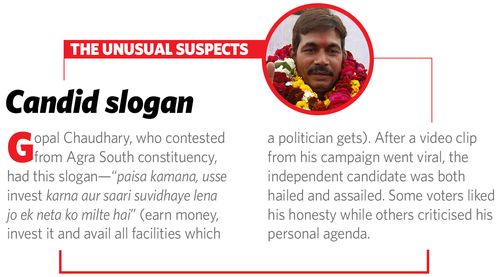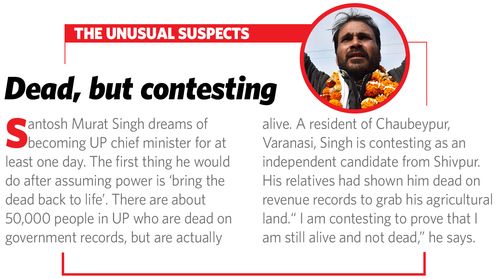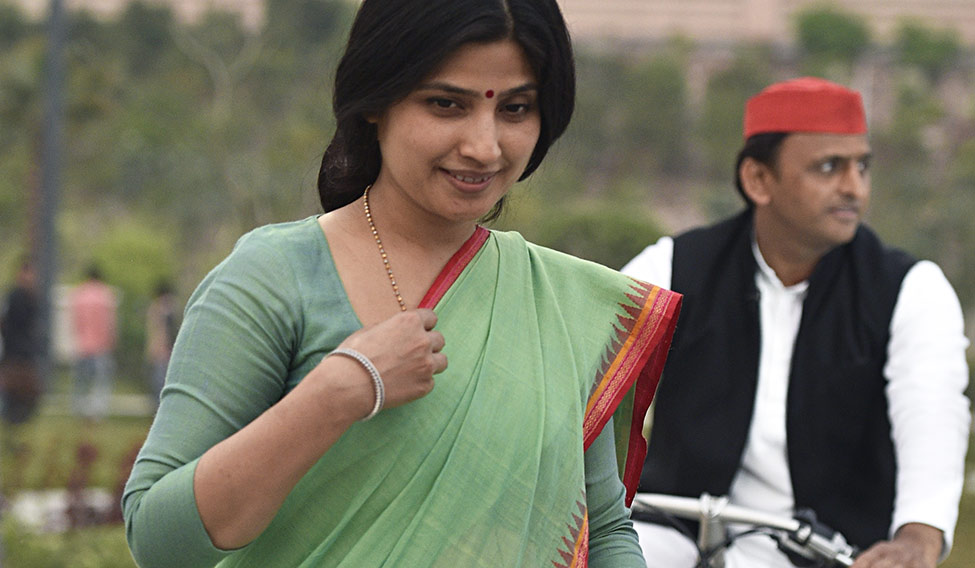It is morning in Lucknow. There is a slight dip in mercury, but the airport at Amausi is feeling the heat. Guarding every inch of the area are commandos of the Special Protection Group and the National Security Guard. On the tarmac are three Air Force choppers and a white chartered plane.
All are waiting for the arrival of two heavyweight political leaders. It is from here that Prime Minister Narendra Modi and Uttar Pradesh Chief Minister Akhilesh Yadav will fly into election rallies in hinterlands. Their destinations are different, but their aim is one: win the assembly elections in the country’s most populous and electorally significant state.
Akhilesh arrives on the dot at 11. Clad in spotless white kurta-pyjama, black Nehru jacket and black Mobils shoes, he boards the plane, but not before greeting the pilots and the people waiting to board the flight with him. He tells the pilots: “Fly quickly. I am already late by half an hour. In the evening I have to address two meetings in Lucknow. After that, there are interviews lined up.”
The Akhilesh of today is a far cry from the one he had been weeks earlier. Back then, he was embroiled in a bitter family feud that pitted him against Mulayam Singh Yadav, his father and founder president of the Samajwadi Party. The support of the majority of SP legislators and some political manoeuvres, however, helped him seize the reins of the party from Mulayam.
As he boards the aircraft, it is clear that Akhilesh has put the whole episode behind him. He is now fully focused on his campaign. As the plane takes off, he takes his cellphone out and scrolls through news of political happenings. His love for technology reflects in the campaign he leads—the Samajwadis are now using all digital tools available to mould public opinion in their favour. “Twitter, Facebook, WhatsApp, email… you will find us everywhere,” Akhilesh tells THE WEEK. “It is a 360-degree campaign. And we are far ahead of our opponents.”

His is a whirlwind campaign. By February 19, when 12 districts voted in the third phase of the assembly polls, Akhilesh had addressed around 85 rallies. He is airborne five hours a day on an average, and addresses at least six public meetings. But, even with the kind of effort he has been putting in, he would not have been able to make the campaign an effective one, if not for one person—his wife, Dimple Yadav.
UP’S POWER COUPLE is a study in contrast. Dimple, 39, is all sophistication and understated elegance, while Akhilesh, 43, comes across as earthy and affable. She hails from a family that has an Army background, while he is the scion of a family that wields influence over the heartland of caste-based politics.

A member of the Lok Sabha from Kannauj, Dimple was known to keep a low-profile. But, as Akhilesh tries to dissociate himself from the old guard in his party and win UP by his own dint, she has truly been a revelation. She has been addressing rallies on her own, demonstrating her ability as a crowd-puller, and has successfully emerged from the shadow of the elders in the party.
Asked about how he felt about Dimple’s campaign, Akhilesh pulls out his cellphone and shows pictures of her rallies. “Look, her public meetings are pulling more crowds than mine,” he tells THE WEEK. “Wherever I am not able to reach, she fills the gap. More importantly, she addresses issues pertaining to women with ease and has great acceptability among them.”
If Akhilesh is ‘bhaiyaji’ to his supporters, Dimple has become their ‘bhabhiji’. At rallies, she tells crowds that, while Prime Minister Narendra Modi has been doing “Mann ki Baat”, Akhilesh believes in “Kaam ki Baat [talk about work]”. She asks the crowd what ‘buaji’ (Bahujan Samaj Party chief Mayawati) has done for the state, and the crowd answers, “Elephants, elephants”, referring to the stone statues built in Lucknow when she was in power. She is greeted with slogans such as ‘Vikas ki chhaabi, Dimple bhabi [The key to development is Dimple]’ and ‘Bhaiyaji ka vikas hai, bhabhiji ka saath hai’.
“Dimple has a good connect with the voters,” says Rajiv Ray, national secretary of the SP. “She is soft-spoken, while Akhilesh has charisma. They are an excellent combination.”
Dimple emerged as Akhilesh’s pillar of support as he took on the party old guard, which included Mulayam and uncle Shivpal Yadav. As the family feud worsened, she is learnt to have insisted on keeping the communication channels open. She also worked hard on projecting a positive image of Akhilesh through social media. A video showcasing some happy family moments was released, and it was titled ‘Apne to Apne Hote Hain’.

“Dimple has done a superb balancing act,” said Kamal Farooqui, who has been closely associated with the Yadav family. “She has been a traditional bahu, who binds the family together, and has been a pillar of support for her husband.”
Akhilesh says his disagreement with Mulayam was more political than personal. “That [the perception that I was taking on my father] was because he was the president. There could have been anyone else in that position,” he says. “So it was not like I was fighting with my father. I was disagreeing on a few issues…. We are taking the party forward. But it is his party basically.”
What does Mulayam say about the decision to join hands with the Congress? “He was not happy for some time. And then he said it was a good thing. Then another day, he said it was not good. You know, that is how Netaji is,” says Akhilesh.
Dimple is now holding strategy meetings in the party, asking publicity managers to focus on the work done by the Akhilesh Yadav government. “She is closely overseeing what is going out to the media. She stresses that it should be a positive campaign, and there should be no personal attacks,” said party leader Naved Siddiqui.
SP insiders say that she has emerged as the second most powerful leader in the party. Mulayam’s favourite bahu, she is used to getting things done the tough way. Hers was a love marriage, and Mulayam was initially opposed to it as she was a Thakur from Uttarakhand. He was also opposed to the idea of Akhilesh initiating Dimple into politics by fielding her in the Firozabad Lok Sabha byelection in 2009, which she ended up losing.
Seven years later, though, the Samajwadis are banking on her skills as they try to return to power in UP. “This is the kind of leadership Indians are looking for, especially the youth,” says Joe Anthony, member of the SP’s parliamentary board. “They [Akhilesh and Dimple] have versatility and experience in politics. Together, they are leading the party.”
AROUND 240KM west of Lucknow is Saifai, Mulayam’s birthplace and pocket borough. A village of around 7,000 people, Saifai boasts a medical university, several colleges and schools, two international-level sports complexes, an expressway, and rail and air connectivity.
The plane that left Lucknow carrying Akhilesh lands on the airstrip close to the village. Waiting for him is an Agusta Grand helicopter, which will take him to nearby areas where his public meetings are scheduled.

A key difference in the Samajwadi campaign this time round is that Akhilesh, and not Mulayam, is the face of the party. In the Lok Sabha polls in 2014, Mulayam had led the SP. The campaign song then was “Mann se hai Mulayam, irade loha hai [Soft-hearted, with iron will].” A new song, composed and sung by Bollywood singer Javed Ali, has now taken its place. “Tarakki ka shubharambh, pragati ka sriganesh… Akhilesh, Akhilesh, sathi sabka Akhilesh [The beginning and initiation of progress… it’s Akhilesh, Akhilesh; friend of everyone],” goes the song.
Akhilesh leaves the plane for the chopper, which is stocked up with protein bars, cookies, cold drinks, sandwiches, coffee and paratha sabji to keep him going. “These days, I do not find time for gymming and exercise, and I am hooked to oily food like poori and parathas,” he says with a smile.
As the chopper flies over Saifai and the nearby Mainpuri, Etawah and Kannauj, Akhilesh shows the expressways and the lion safari and power plant built by his government. “We have done a lot of work,” he says. “See the expressway? Now you can reach Lucknow from Kannauj in one and a half hours. And they say we have not done anything.” He is referring to Modi and BJP president Amit Shah, who have been attacking Akhilesh saying UP is underdeveloped.
Even as he speaks, he gets updates on his cellphone about what Modi is saying in his rallies. At Barabanki, Modi made one of his severest attacks, saying police stations in the state had become offices of the Samajwadis. What he implied was that the ruling party had posted personnel of a particular caste in most stations.
As Akhilesh comes to know of Modi’s statement through his cellphone, he tells THE WEEK: “Is this a PM-level speech? Modi has stooped to the politics of police stations, when he should be raising national and international issues.”
Perhaps, what sets Akhilesh apart from older Samajwadis is his keen understanding of the dynamics of modern-day election campaign. He knows that high-decibel rallies alone cannot do the trick; one needs a technology-driven communication strategy to reach out to the maximum number of voters. To this end, he has set up a war room that works in tandem with the party’s established campaign machinery. It is located at the office of the Janeshwar Mishra Trust in Lucknow, which used to be the base of the Akhilesh-led youth brigade when the family feud was being played out. “The focus is on disseminating authentic information about constituencies and candidates, and tell the contestants how to go about campaigning,” says Aashish Yadav, the in-charge of the war room.
Akhilesh has learnt well from his party’s rout in the Lok Sabha elections (it could only bag five out of 80 seats). In October 2015, he met Gerald J. Austin, who designed campaigns for US presidents Barack Obama and Bill Clinton. “A team was sent to Akron university in Ohio in 2016 to learn about poll techniques,” says Ashish. “The focus was macro- and micro-management of voters.”
In 2016, Akhilesh consulted Steve Jarding, a Harvard University professor who was campaign strategist for former US secretary of state Hillary Clinton, Spanish Prime Minister Mariano Rajoy and former US vice president Al Gore. “We were advised to play up the neat-and-clean image of the chief minister, his pro-development stance and the good connect with the masses,” says Ashish Yadav, head of the SP’s media team.
The party has done well to heed that advice. But Akhilesh himself knows that the battle is far from easy. This time, he has to tackle a strong BJP, which has 71 MPs from the state and is led by none other than the prime minister. Also going against him is the law-and-order situation: riots, rapes and murders have overshadowed the good work done by his government.
There is also a tradition to break. For the past several decades, UP has not reelected chief ministers. The SP, the BSP and the BJP have all come to power in the state, but not on successive occasions.
What, however, could turn things in Akhilesh’s favour is that he has already broken tradition by bringing in Dimple as his second in command. From the way they have been campaigning, it is evident that UP’s power couple is in for the long haul. And, if Akhilesh succeeds in returning to power, they could well find themselves playing a decisive role in national politics.

As THE WEEK meets Akhilesh and Dimple at the imposing marble-lined hallway of 5 Kalidas Marg, the chief minister’s official residence in Lucknow, it is hard to miss their crackling chemistry.
Both of them have taken a brief break from their hectic schedule to pose for the cameras. Dimple looks at her husband as he tidies up his looks. “Your hair is all sticky,” she says. “It needs to be washed.” She then proceeds to comb his hair, which has taken a beating from the elements during a long day of electioneering, with her fingers.
They may come from contrasting family backgrounds, but it is evident from they way they speak and behave that the couple complement each other. When questions are asked, they reply for each other and add to each other’s answers.
When Akhilesh says he feels bad that he could not undertake a cycle yatra like he had done in the previous assembly election, Dimple replies, “You can do that after the elections are over.” Akhilesh nods, saying it will help him connect with the people. And, when he tells her that she has filled in for him well with her rallies, she promptly retorts: “OK, so I am the filler!”
And then they pose for the cameras, smiling. They look young, confident and beautiful. Do they know they are UP’s power couple? “You guys coin catchy terms,” says Akhilesh. “I am here to work for people.” And Dimple joins in: “We are simple and down-to-earth people. We are nothing like a power couple. He and I personally believe in working for the masses.”
WITH SONI MISHRA





